A Group of Young Afghan Women Reach New Heights Trekking in Nepal
Three teens from Kabul reach personal summits while mountaineering
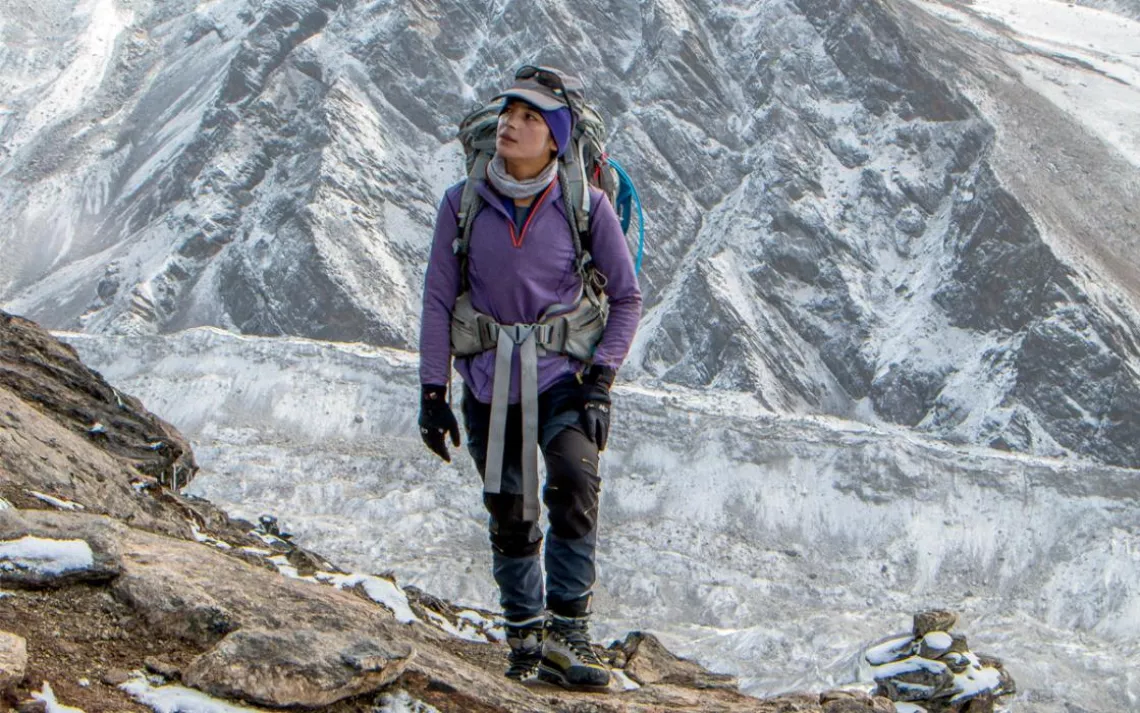
Shogufa Bayat on a trail near the summit of Gokyo Ri | Photo by Wendy Becktold
THE TRAIL TO THE WORLD'S TALLEST mountain range starts out surprisingly easy. Flanked by rocky, low-lying hills, the route to Mt. Everest meanders along the emerald froth of the Dudh Kosi River as it tumbles down a forested valley. Our group of 10 sets off on the dusty path in mid-afternoon just as a few isolated drops of rain begin to fall.
We pass through Sherpa villages, their entry points marked by large, white stupas. Higher up in the mountains, the terrain is rugged and undeveloped, but down here, guesthouses and restaurants line the route. Small shops sell Snickers bars, water bottles, toilet paper. A few advertise espressos.
We are in Nepal's Khumbu region, a mostly roadless stretch of the Himalayas that borders Tibet. When the weather is good, small passenger planes deposit trekkers by the hour at the airport in Lukla, on its one, edge-of-a-cliff runway. Once in the mountains, the only way to get anywhere is by foot or helicopter.
We step aside for long strings of donkeys and yaks piled with jugs of fuel, boxes of crackers, bottles of Coke and beer, and oversize duffel bags. Heavily loaded porters trudge by, their pace slow and rhythmic. One passes me murmuring—a Buddhist prayer? No, he's on the phone, a thin wire snaking from his ear.
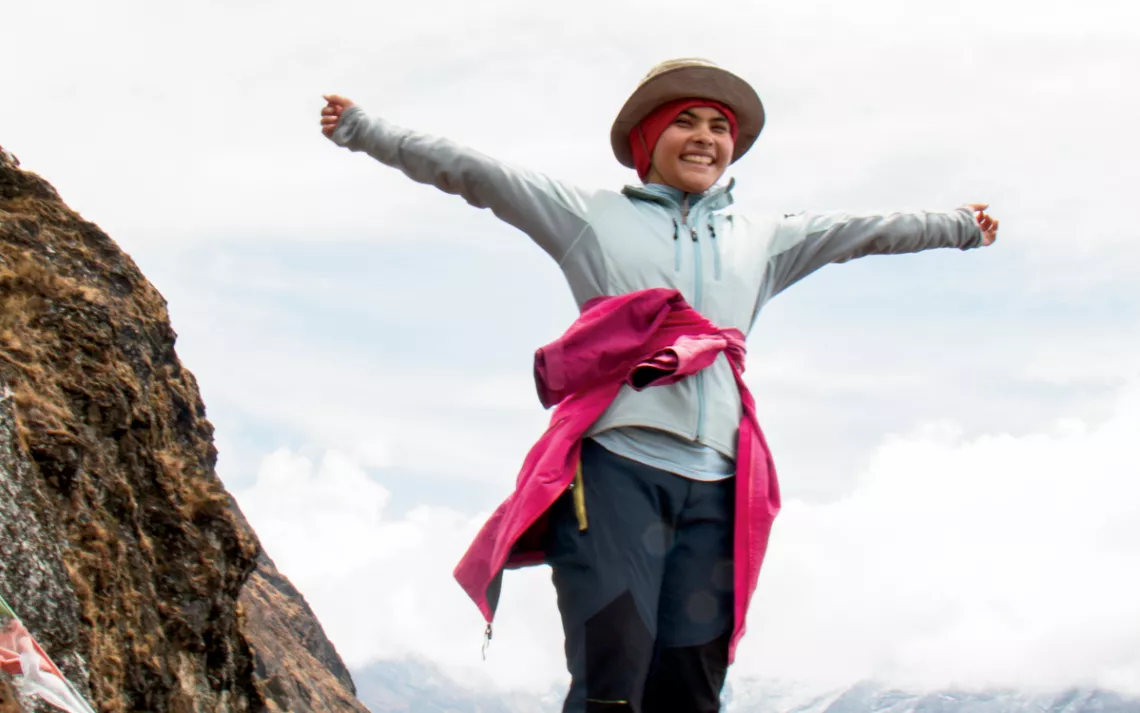
Eighteen-year-old Neki Haidari celebrates after climbing a mountain above the village of Phortse. "All people like climbing in the mountains," she says.
Spring is prime trekking season, and the trail is crowded with travelers from all over the world, many on their way to Everest Base Camp. Others, like us, are here to traverse well-worn paths between villages, to take in the stunning views, and to climb smaller, lesser-known peaks. We walk to the soundtrack of different languages—Sherpa, Nepalese, German, Spanish, French, Italian, Chinese, Hindi, and English in a swirl of accents.
We are the only group with Dari speakers. This expedition includes three young Afghan women—18-year-olds Shogufa Bayat and Neki Haidari and 19-year-old Mariam Muhammadi. They stop now and then to snap photos of each other with their phones, their slight frames laden with donated gear, their dark hair carefully tucked under hats and scarves.
For the past two and a half years, Mariam, Shogufa, and Neki have taken part in Ascend: Leadership Through Athletics, a program in Kabul that trains Afghan girls to climb mountains. Danika Gilbert, the program's expedition leader, organized this trip to Nepal and is leading us on a 15-day trek. Her partner, Dave Penney; our guide, Lhakpa Norbu Sherpa; a porter, Ambar Bahadur; and two American program sponsors and I make up the rest of the group.
I met the three girls a few days ago in Kathmandu, where, over lunch at a traditional Nepalese restaurant, they talked about their hopes for the trip. Shogufa graduated from high school last year and is a program assistant for Ascend. "I want to learn more about mountain climbing so I can teach the new girls," she said. Mariam, in her first year of college and also a program assistant, nodded. "We should learn more technical skills," she said. "Mountain climbing is difficult in Afghanistan. It's not safe to go to the mountains every day for practice."
The youngest of the three, Neki is in her last year of high school and is missing class for the trek. "Before Ascend, I didn't exercise very much or spend time outdoors," she said. Through the program, she and other participants do fitness training several times a week. They go on a carefully planned excursion once a week. And a few times a year, they go on longer expeditions, usually to the mountains of Panjshir Province, in the north of the country, or in Bamyan Province, to the west of Kabul.
While in Nepal, the three girls hope to summit Machhermo Peak. At about 20,500 feet, it would be the highest they had ever climbed. "Mountain climbing is a very new sport in Afghanistan. We are the first female Afghan climbers," Shogufa said. "Girls have a problem in Afghanistan. We can't choose the way for us. It is very hard, but we want to change that Afghan culture."
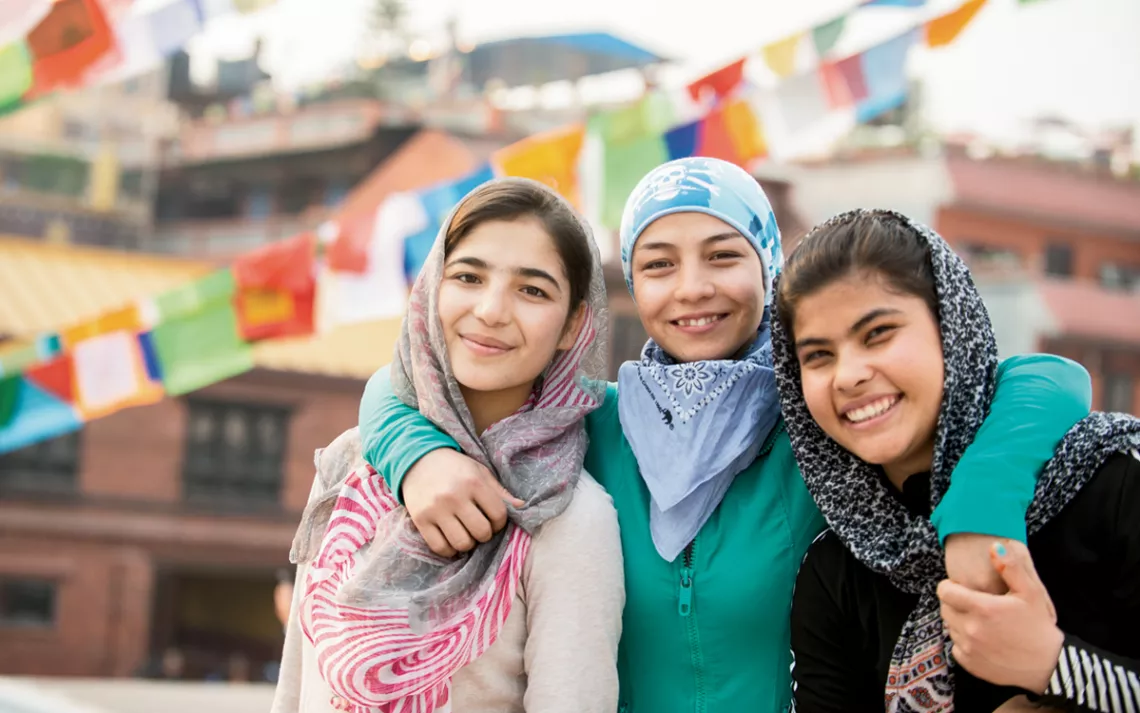
Shogufa, Neki, and Mariam Muhammadi in Kathmandu. | Photo by Crystaline Randazzo
The three girls said they also want to change how people from other countries see Afghans. "We want to show other countries that Afghanistan is not always fighting," Shogufa said. "We have good women and men. The Afghan woman does not always wear burqa." She paused. "I've never worn burqa!" It would be hilarious, the three agreed, to climb up to the top of a mountain, don a burqa, grab an ice pick, and pose for photos.
WE ARRIVE AT THE Hidden Valley Lodge in Khumjung midway through our third day of trekking. Now above 12,000 feet, we need time to adjust to the altitude, so we'll go no farther today. The dining room is teeming with members of an International Mountain Guides (IMG) expedition. They are on a trek to Everest Base Camp, where four of the 17 will attempt to summit the peak.
Across the room, we see Ben Chan. We met him on the trail yesterday. The 19-year-old from Hong Kong aims to be the youngest person to achieve the Explorers Grand Slam—by summiting the highest peaks on all seven continents and reaching the North and South Poles. He has already climbed Mt. Kilimanjaro in Africa and Mt. Aconcagua in South America. Like the girls, he has been mountain climbing for only a few years. When we met him, he told us that he just wanted to do something crazy and inspire other people. It seemed like a naive sentiment; still, we couldn't help liking Ben, with his friendly smile and his messy man-bun.
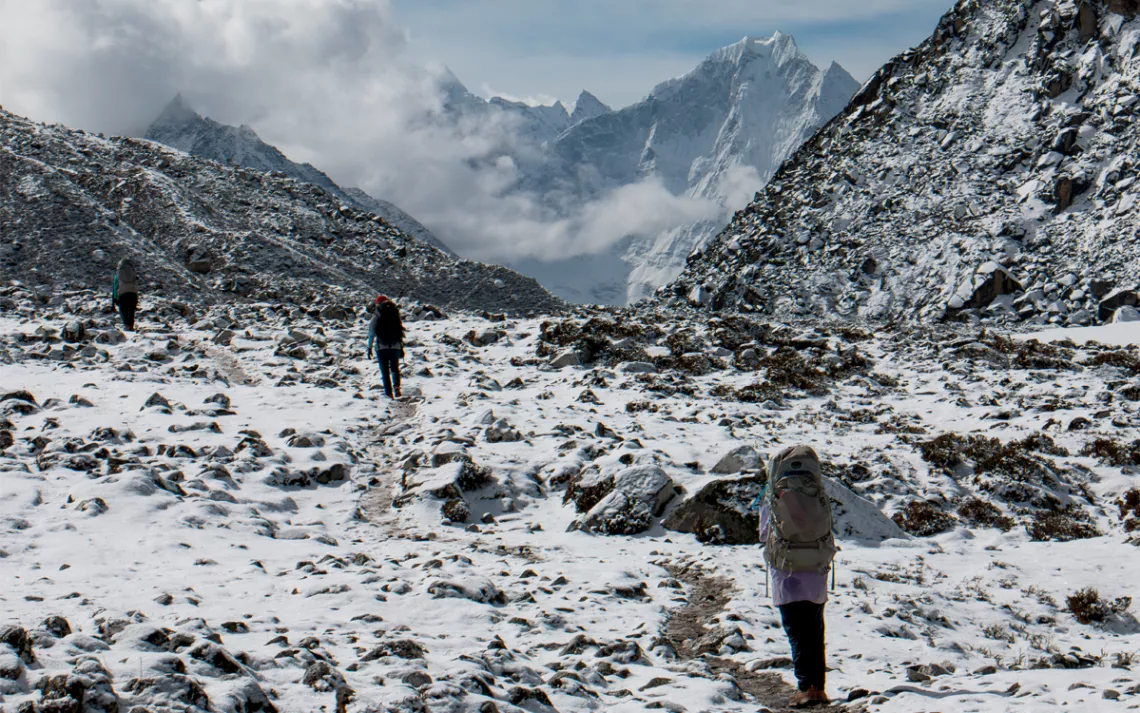
The girls descend from Gokyo village.
Now he sits down at our table and asks Neki, Shogufa, and Mariam to teach him some Dari. They have him repeat after them "How are you?" and "What is your name?" The three girls can't stop laughing. The scene is so ordinary, their teenage chemistry so natural, it's easy to forget that for the three Afghan girls, this isn't normal at all.
"The girls have never done this before—spent time with a boy their age who is not a relative," Danika says, watching them. She gets misty-eyed. "This is so good for them."
The IMG expedition leader, Emily Johnston, comes over and introduces herself. She has wild, curly gray hair and a warm, weathered face. She takes a keen interest in the Afghan girls. "They are the first women in their country to be mountain climbers," Danika says proudly.
"I started mountain climbing in 1976," Emily says. "I was one of the first female guides on Mt. Rainier. IMG tries hard to hire female guides, but there are still only seven out of about 40 total. It just has not changed enough."
Meanwhile, the girls are still cracking themselves up, writing out phrases in Dari and making Ben copy them. Their right-to-left cursive is tight and elegant; his is loopy and sprawling. Then they all get up abruptly and rush outside to take pictures.
Eventually, the IMG group moves on. After lunch, the temperature drops, and it starts to snow. In their room, Neki, Shogufa, and Mariam push the beds together and climb under a pile of blankets. Through the thin wall, I can hear them talking and giggling—it's a daytime slumber party.
That evening, I go to the dining room to warm up by the stove. I find Shogufa scrolling through photos on her phone and crying softly. She has missed a family gathering today in Kabul, and she's homesick. Shogufa is especially close to her father. Two years ago, when she asked her parents if she could join Ascend, her mother said no, but her father said, "If you want to do climbing, it's your choice." She likes to tell him everything she does, to the point that sometimes he asks her to be quiet. "It's too much!" he says. "You don't listen to my advice anyway."
Shogufa, her four siblings, and her parents share a five-room house with her uncle, his wife, and their four children. Her uncle does not approve of her mountain climbing. He argues with her father about it and chastises her for not being married yet. But Shogufa has always had a mind of her own. When she was 15, she bought herself a bike. She rode it to school and back every day for more than a year, past openmouthed bystanders who were not used to seeing a girl on a bicycle. One day, her older brother confronted her, saying that it wasn't proper for a girl to ride a bike. They argued, and he hit her so hard, her nose bled. She stopped riding her bicycle, and not long after that, her brother sold it. I hear Shogufa tell this story several times during the trip. She laughs while she tells it, but by the end her voice grows quiet. "Bike is always in my heart," she says.
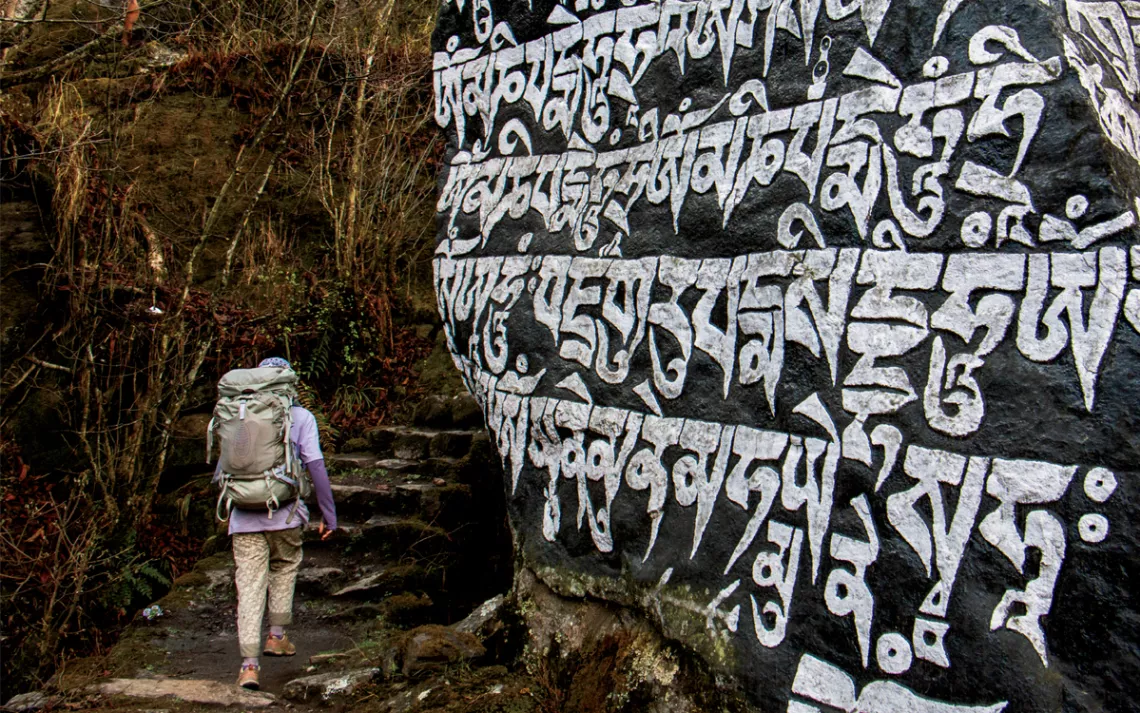
In the Nepalese Himalayas, many trails are flanked by mani, stones inscribed with Buddhist prayers.
Over the next two days, we follow a tributary to the west of the Dudh Kosi. In the village of Pangboche, we put down our packs and go for a stroll above town. Now higher than 13,000 feet, we are surrounded on all sides by famous, white-capped peaks—Kangtega to the south, Ama Dablam to the northwest, Everest to the far north. From this distance, Everest looks modest compared with Ama Dablam, which arches dramatically near its top like a treacherous playground slide.
We spread out along a ridge, everyone walking at their own pace. Neki, Shogufa, and Mariam are lower down, squeezed three abreast on the trail, walking arm in arm. They step buoyantly, energized by the sharp wind, the expansive view, the immense grandeur of the mountains.
That same afternoon, we return on the other side of the tributary, on a trail carved high into the mountainside. From here, the river looks like a frozen band of turquoise. We are off the main route to Everest Base Camp now, so we meet far fewer trekkers. The sun shines hot, and it's hard to remember how quickly the weather can change, to anticipate that it will be snowing by late afternoon. Himalayan tahr—wild goats—graze on the sheer, scrubby slopes and eye us warily from rocky ledges.
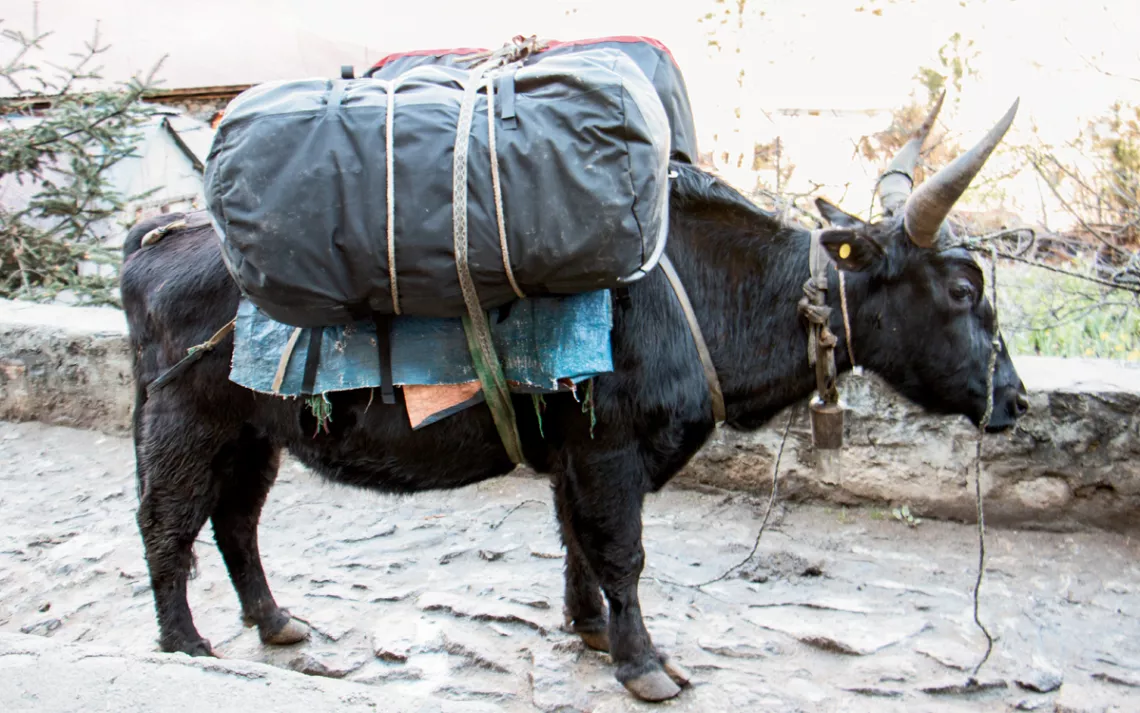
Trekkers' journeys are often made easier by pack animals that transport gear, like this yak.
Danika keeps reminding Shogufa, Neki, and Mariam that they are here to hone their mountaineering skills, so they can lead trips for the Ascend girls back home. At night, she has them study the map. They calculate the distances between villages and track the elevations. On the trail, the three divide up and match their paces to those of the other group members, and they monitor how we are coping with the increasing altitude.
One morning, Neki and I walk together and get to talking about her family. Her mom and dad—do they know how to read? Her father can read the Koran in Arabic, she says, but otherwise no. "Sometimes my mother says, 'Teach me to read!,' so I show her 'A, B, C…,' but then she says, 'Oh, my eyes hurt!'"
Neki heard about Ascend two years ago from a fellow student in her art class. When she asked her mother if she could sign up, her mother refused, saying she wanted Neki to concentrate on her studies. "If you were a boy, I would still say no," she told her daughter. But Neki begged her every day for a week, and she finally relented. Now her mom approves of Neki's mountain climbing, though sometimes she teases her about it. As a girl, Neki's mother herded sheep, so she likes to tell her, "When I was young, I went to the mountains to work, not to play!"
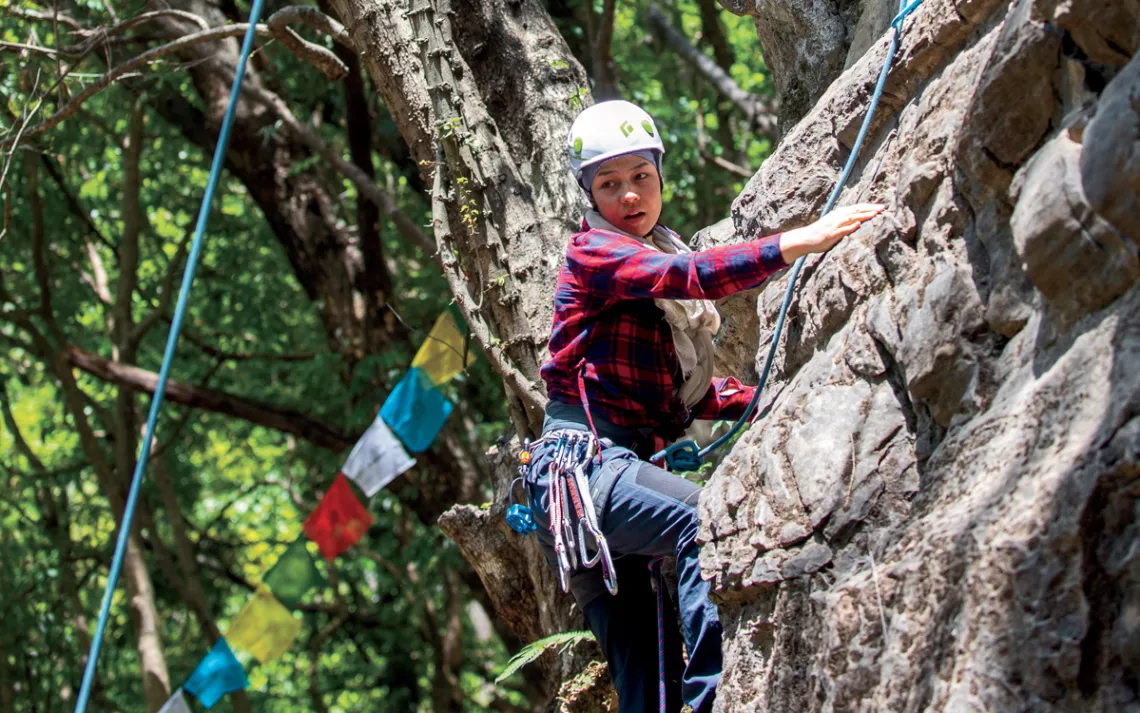
Nineteen-year-old Mariam rock climbs in the Nagarjun Forest Reserve outside Kathmandu. | Photo by Crystaline Randazzo
In the village of Machhermo, we rest for a day in preparation for summiting nearby Machhermo Peak. While Danika and Dave scout out routes for the climb, some of us head up a small mountain above the village. On top of a low, flat boulder, Neki and Mariam practice headstands. They fall over laughing and try again.
We climb farther up the scrubby slope. A wet fog settles in, and the wind picks up. The cold is miserable. We decide to go back down, but Shogufa and Mariam convince Lhakpa to continue with them to the top. Afterward, they show us photos of themselves at the summit, waving the Afghan flag against a dense, gray background.
Sometimes, Danika worries that the girls are too focused on summiting peaks, on setting new records for height. She's an accomplished climber, but when asked, she's hard-pressed to remember the altitudes of the peaks she's climbed, or even their names. It's just not important. Danika loves the exploration itself as well as the camaraderie she finds in the climbing community. She tries to cultivate this same love among Ascend team members, hoping that the support system and sense of self they develop will remain with them no matter what happens.
Shogufa, Mariam, and Neki are too young to have known life under the Taliban; its government fell in 2001. But since then, they and their families have had to endure economic insecurity and ongoing violence. When Shogufa was 13, a gun battle erupted outside her middle school and all the windows were blown out. Not long ago, a suicide bomber blew himself up in front of the police station where Neki's older sister works (she suffered a broken arm). Each time the girls leave their houses, their parents worry they will never see them again.
Social customs also narrow the opportunities available to the three. In Afghanistan, more than one-third of girls are married by the age of 18. As they get older, Shogufa, Mariam, and Neki feel increasing pressure to marry, which would likely put an end to their mountain climbing. (The three tell me they prefer to be called "girls"; to them, "women" means that the door to new possibilities has closed.)
All of this keeps Danika up at night. The girls have so little control over their lives. What if by taking them out to the mountains, she is just giving them a taste of something that in the long run they cannot have?
For better or worse, being in Nepal has opened the girls' eyes to a new world. They are surprised by all the different people who come to Nepal to trek. Not just the combination of nationalities, but also the mix of young people, old people, some with friends, some with their families. "All people like climbing in the mountains," Neki says. Afghanistan has beautiful mountains too, the girls say. It could be like this if the fighting stopped.
When we reconvene at dinnertime, Danika and Dave have bad news. After a mild winter, Machhermo doesn't have enough snow on it—there is too much loose gravel to traverse. "It will take 12 hours just to summit, and bad weather is supposed to move in," Danika says. Instead, we'll hike to the village of Gokyo and from there climb Gokyo Ri, a smaller, nontechnical peak of 17,770 feet. Mariam, especially disappointed, puts her head down on the table.
Before participating in Ascend, Mariam struggled with health problems and depression. When she was five, her mother died of a heart attack. A year later, her father got married to a woman who beat her and her younger sister. When she was 11, she had a seizure at school. After that, she had them almost daily. During her seizures, she was far, far away—when she came to, she remembered nothing.
When Mariam asked her father's permission to join Ascend, he forbade it. He was terrified that climbing to high altitudes would make her health worse. "I already lost your mother," he said. "I don't want to lose you." She convinced him to let her try. She went on her first expedition in 2016 in the Panjshir mountains. She was so unfit, she could barely hold her backpack, and she had to be carried back down the mountain. But she didn't have a seizure. "I was happy, and my mind was relaxed," she says. Her seizures gradually subsided; by 2017, they seemed to have stopped completely.
Through Ascend, Mariam also started doing yoga. At first she thought the poses were strange, but as her practice deepened, she started thinking about her life. She realized that she didn't have to accept things as they were and could try to make her life better. Now she teaches yoga to other girls in Ascend. She dreams of opening a yoga studio in Kabul, one that regular people can afford. In particular, women and girls need it, she says. Their lives are difficult inside and outside the house.
AT 15,500 FEET, the village of Gokyo is perched above the Dudh Pokhari, one in a chain of six high-altitude lakes. When it's sunny, the lake glows brilliantly, but in the predawn light it's colorless. We pass it on our way to Gokyo Ri, shivering in the chill left over from last night's snowfall.
At the base of the mountain, we see a maze of trails winding upward, each a minor variation on the last. Six of us will make the climb. We are quiet, tired before we've even begun—from getting up so early in the morning, from the unseasonable cold spell that has dogged us, and from the high altitude. Neki has had a nagging cough since Khumjung. Mariam has had trouble sleeping. All three girls look pale and haggard.
Other trekkers are well on their way to the top; a few are already heading down from the summit. The most cautious are fully geared up in snowsuits and climbing boots, which seems like overkill. The route is more mud than snow, and it's getting warmer as the sun rises. It's only about a two-hour hike to the summit, but the altitude and the sharp climb make us feel like our bodies, and time itself, are moving in slow motion. We plod, one foot in front of the other, up the steep, treeless slope.
Shogufa, Mariam, and Neki gradually fall behind. I continue, knowing that if I stop to wait, it will be hard to start moving again. Around 8 A.M., I reach the craggy summit, strewn with piles of ragged prayer flags. The sun is shining, and I see mountains in all directions: Cho Oyu to the north, on the border with Tibet; Everest, Lhotse, and Makalu directly in front of me; Cholatse and Taboche to the south. The whole world is rock and ice and sky, the planet's tallest peaks in intimate proximity. Below Cho Oyu, the Ngozumpa glacier stretches 22 miles, the longest glacier in the Himalayas. Gokyo village is in miniature, and so is the lake, now bright turquoise.
Shogufa crests the top first. She tells me that Neki felt sick from the altitude and turned around halfway up. Mariam trudges up the last few feet of the trail, and the two of them drink in the view. It's not Machhermo Peak, but still, they are elated. It's the highest they have ever been.
That evening, Danika calls a meeting. We are supposed to cross Renjo La Pass tomorrow, but with the cold weather, the route may not be open. Also, while Neki is feeling better, Mariam still looks pale. We could split up, Danika says, with some of us forging ahead over Renjo La, or we could all go back the way we came, to lower altitudes, maybe summit another small peak or do some rock climbing. "I want to stay together," Shogufa says. "Stay together," Mariam echoes. Neki nods. "I want to go rock climbing," she says, and we all agree to retrace our steps. Later, when Shogufa is back in Afghanistan, she will remember this moment—how everyone was consulted, how her opinion mattered.
The next morning, we walk to Dole, a town just below Machhermo. Even though she's going downhill, Mariam stops often to rest. She seems alarmingly weak. That night at the lodge, she has no appetite. Danika fusses over her like a mom, ordering different food on the menu and trying to get her to eat.
Then at breakfast, Mariam has a mild seizure. It's a three-hour walk to the closest helicopter pad, in Phortse. Mariam insists that she can make the trek. Ambar, our porter, offers to carry her, but she refuses. She won't take off her backpack. We empty it out and let her keep it on. "I don't need hospital, Danika," she says softly.
We make it to Phortse, but Mariam has several more seizures. On the second morning there, she and Danika take a helicopter back to Kathmandu. It touches down and lifts off so quickly that the rest of us barely have a chance to say goodbye.
We continue our descent out of the mountains, subdued by the turn of events and worried about Mariam. But our moods improve the lower we get. Spring is creeping up the mountainside. The weather is warmer, and the trees bloom fragrantly. Trekkers pass us, heading uphill, looking fresh and untested, smelling like soap.
As we walk, I find myself thinking about Ben Chan and his ambition to climb the tallest mountains on all seven continents. Bolstering him in this endeavor are money, his sponsors, his airtight medical-evacuation insurance, and a lifetime of proper medical care and good nutrition. As mountain climbers, he and the girls do not share the same starting point. But in their own way, Shogufa, Mariam, and Neki are just as ambitious. For them, making it to the top of Gokyo Ri, or the top of any peak at all, is its own kind of grand slam.
On day 15, we fly back to Kathmandu, where we reunite with Danika and Mariam. Mariam looks rested. While we finished the trek, she had a full workup at the hospital, and doctors prescribed anti-seizure medication.
On our last day together, we plan to head to the hills outside Kathmandu to do some rock climbing. Mariam wants badly to come. Danika says she can. We drive to Nagarjun Forest Reserve, just above the western end of the city, and walk up a short hill to where a bare rock face rises out of the jungle.
Shogufa leads, clipping the rope along the bolted route. When it's Neki's turn to climb, Mariam belays her, expertly pulling and releasing the rope. She shouts instructions and gives advice, bracing her legs firmly against the ground.
She is standing exactly where she needs to be.
This article appeared in the November/December 2018 edition with the headline "To Climb a Mountain."
This article was funded by the Sierra Club's Gender, Equity, and Environment program (sc.org/gender).
MORE ONLINE
Click here to see photos and learn more about the trek in the Khumbu.
Read a Q&A with the first Afghan woman to summit Afghanistan's highest peak.
 The Magazine of The Sierra Club
The Magazine of The Sierra Club



